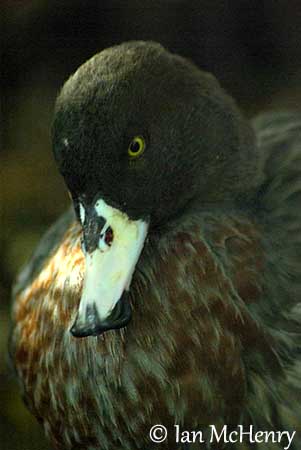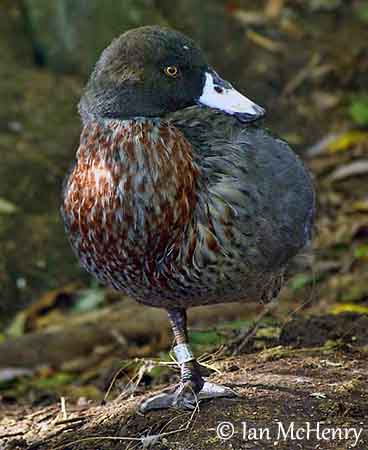
Fr: Canard bleu, Hyménolaime bleu
Ang: Blue Duck
Maori: Whio
All: Saumschnabelente
Esp: Pato Azul
Ita: Anatra dei monti della Nuova Zelanda
Nd: Blauwe Eend
Sd: Blåand
Photographer:
Ian McHenry
My New Zealand Birds
Text by Nicole Bouglouan
Sources:
HANDBOOK OF THE BIRDS OF THE WORLD vol 1 by Josep del Hoyo-Andrew Elliot-Jordi Sargatal - Lynx Edicions - ISBN: 8487334105
KNOW YOUR NEW ZEALAND BIRDS by Lynnette Moon - New Holland Publishers – ISBN: 1869660897
GUIDE DES CANARDS, DES OIES ET DES CYGNES – de Steve Madge - Delachaux et Niestlé - ISBN: 2603013769
BirdLife International (BirdLife International)
New Zealand bird status between 2008 and 2012
New Zealand birds and birding (Narena Olliver)
Wikipedia, the free encyclopaedia
Te Ara – The Encyclopedia of New Zealand
Blue Duck
Hymenolaimus malacorhynchos
Anseriformes Order – Anatidae Family
INTRODUCTION:
The Blue Duck is endemic to New Zealand where its Maori’s name is “Whio”. This specific duck is the unique member of the family Hymenolaimus. It lives on fast-flowing inland streams, and nests along the riverbanks, where it is vulnerable to predation. Its behaviour is fairly similar to that of the Torrent Duck.
The Blue Duck is rare and listed as Endangered.
DESCRIPTION OF THE BIRD:
Biometrics:
Length: 53-54 cm
Weight: M: 890 g – F: 750 g
The adult has blue-grey body plumage, with green gloss on head, neck and back. Mantle and scapulars are slightly spotted blackish. The outer secondaries show whitish tips both above and below.
On the underparts, the breast is conspicuously spotted chestnut. The undertail feathers are brown.

The head is usually darker grey with brown wash on crown and nape.
The peculiar bill is pinkish-white with black nostrils and nail. We can see soft, fleshy black edges on each side of the tip. This morphological feature is a protection from abrasion when the duck feeds among and on rocks, and is also used to filter the aquatic food.
The eyes are yellow. The strong legs and the large webbed feet are dark grey, well-adapted to the behaviour of this duck spending most time in fast-flowing waters.
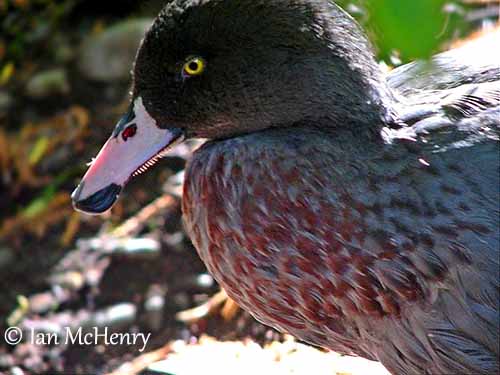
Both sexes are similar, but the female has the breast less spotted than male, and she is smaller.
The juvenile resembles adult but the breast is only speckled dark brown. On the wings, the coverts are washed brown. The bill is pale blue-grey with blackish culmen. The eyes are dark brown.
It gains the adult plumage at 6 months old and the yellow eyes at 9 months.
RANGE:
Although the South Island birds are larger, the Blue Duck is a monotypic species present on both North and South Islands in New Zealand. It occurs in W South Island, especially Otago and Southland, and locally in C north Island in national parks.
HABITAT:
The Blue Duck is usually found in alpine river regions, and it favours cascading, bush-fringed rivers and streams banked by gorges. This species is rarely seen in open or side creeks.
It lives all year round on fast-flowing rivers from which it gets all its food.
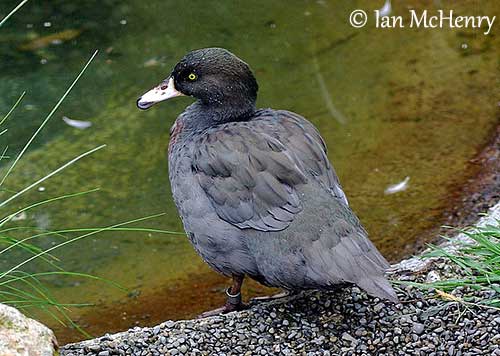
CALLS AND SONGS:
The Blue Duck male gives high-pitched whistles as advertising calls and during the defence of the territory. Short “whi” or “whio” can be heard with intruders. The female gives guttural, rasping growls if disturbed or threatened.
BEHAVIOUR IN THE WILD:
The Blue Duck feeds in the water while swimming, by dipping head and neck under the surface. It also dives well and performs dabbling, upending, pecking in shallow water, and takes insects from rocks. It is usually found at river’s margins, where the current is quieter among rocks.
It is able to detect the preys by sight because it has a wide binocular field of view and it can see directly forwards. It feeds in the early morning and the late afternoon, and sometimes by night. It feeds mainly on invertebrates of various species such as aquatic insects, caddis-fly larvae and grubs falling from trees. It also takes algae and berries, especially in autumn.
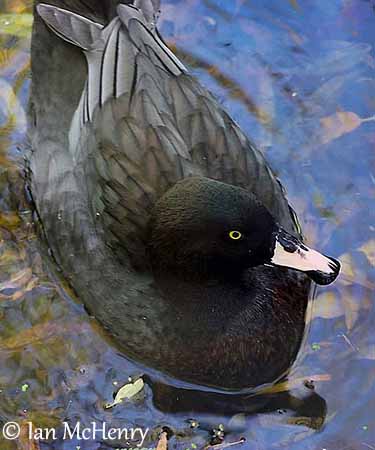
The Blue Duck is commonly seen in pairs, and they remain on the same territory all year round, a part of the river and the shore. They are very terrestrial and usually chase away all intruders from their area.
The blue-grey plumage blends well with the habitat, and only the pale bill can be seen when the bird moves its head. If disturbed, it dives into fast-flowing current, swimming rapidly away. It may also flatten on rocks, waiting and sighting an intruder or a predator.
After the breeding season, they remain in family groups. They are monogamous and solitary nesters.
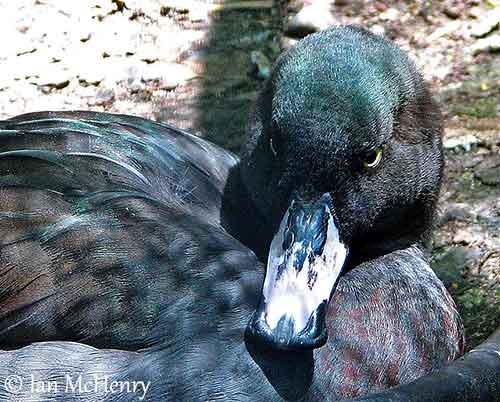
The Blue Duck is sedentary and remains in its territory all year round and often for life. But some transalpine movements by juveniles are reported. After wandering during the first year of life, they usually return to the same area and often establish the territory in the surroundings of their natal area.
The Blue Duck can fly very quickly. Both mates can be seen skimming low over the water with rapid wingbeats.
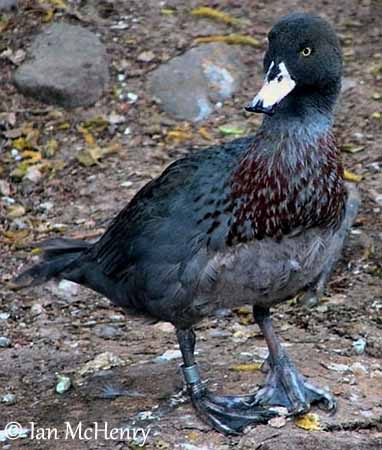
REPRODUCTION OF THIS SPECIES:
The breeding season takes place from August to December.
The Blue Duck nests near water, on banks beneath the thick vegetation, under overhanging rocks, but also in hollow log, small cave or rock crevice, less than 30 metres from water where they are threatened by spring floods.
The nest is a pile of grasses and small sticks, lined with down.
The female lays 4-7 creamy-white eggs at intervals of 24/48 hours. She incubates during 33-35 days while the male remains in close vicinity of the nest. At hatching, the chicks have brown down above and white below. They can swim and dive soon after hatching. They remain in family groups during 70-80 days, tended by both parents within the territory. The adults moult while the juveniles are unable to fly.
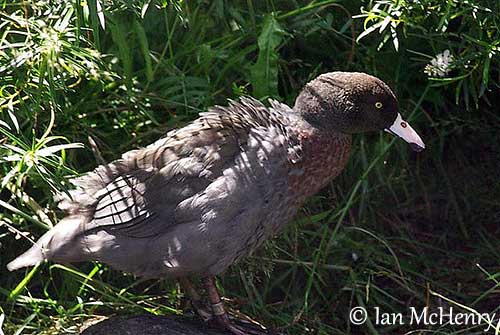
PROTECTION / THREATS / STATUTS:
The Blue Duck is vulnerable to predators such as stoats and possums while nesting on the ground. The clearance of the waterside vegetation has reduced available habitat, and the introduced trout competes for food. Human disturbances on the rivers and developments on adjacent areas threaten the habitat too.
Several conservation measures are underway, such as creation of protected areas, egg-monitoring with release of the juveniles, and predator control.
The population is estimated at about 1,200/1,800 individuals. The Blue Duck is currently listed as Endangered.
